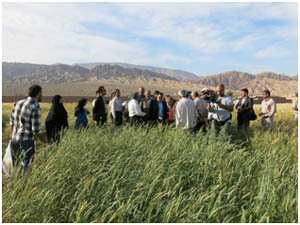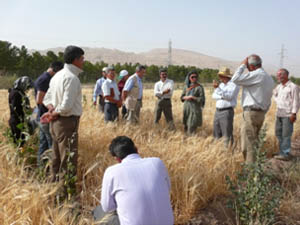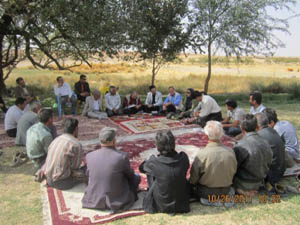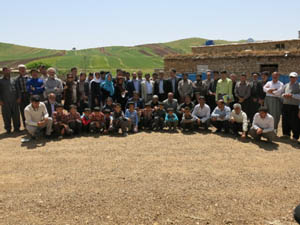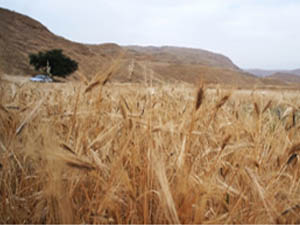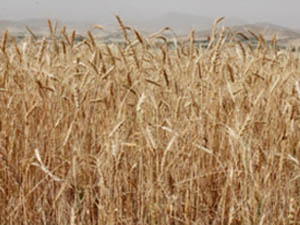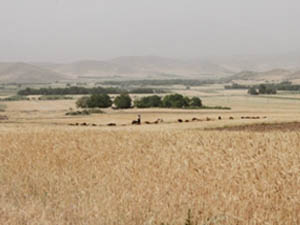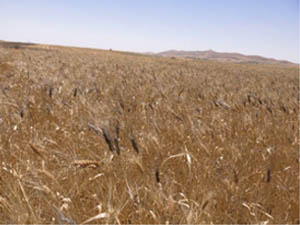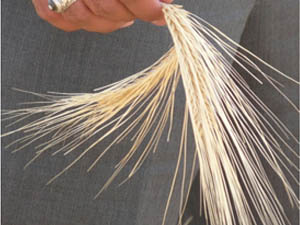Issue : 1 Article : 5
Using Agricultural Biodiversity and Farmers' Knowledge to Adapt Crops to Climate Change
Maedeh Salimi, maede@cenesta.org Salvatore Ceccarelli, ceccarelli.salvatore83@gmail.com Maryam Rahmanian, maryam.rahm@gmail.com
|
The UN predicts that by 2050, world food production will need to increase by a minimum of 70% to feed a projected world population of nine billion and it is clear that extraordinary improvement in agricultural productivity will be necessary. However, it is also recognized that a shift to an agro-ecological modes of production is urgent (De Schutter, 2014) considering not only the challenges of climate change, decrease of biodiversity, poverty, and water scarcity, but also the increasing evidence of a population overfed and undernourished. While in the past, food security has been pursued at the expense of food safety, with the burden to society of increases in the frequency of obesity (Ng et al., 2014), diabetes (International Diabetes Federation, 2013), and more recently newly diagnosed and food-related diseases such as non-alcoholic steatohepatitis (NASH) (Leslie, M., 2015), it is now urgent to shift the development pathways, in ways that will nourish and not only feed the planet. Today, there is a contradiction between the emphasis that major scientific journals give to the importance of biodiversity and the dangers associated with its decline (see for example, Cardinale et al., 2012; Hooper et al., 2012) and the pursuit of uniformity by plant breeding, the science which develops the plant varieties which eventually produce our food (Ceccarelli et al., 2013). Not only the continuous decline of agro-biodiversity in the field increases the vulnerability of our crops (Esquinas-Alcázar, 2005; Hajjar and Hodgkin, 2007; Keneni et al., 2012), but also as our food becomes progressively less diverse, it increases our vulnerability to diseases such as asthma and several types of cancer (von Hertzen et al., 2011). The tendency of modern plant breeding towards uniform varieties appears the opposite of what the world would need to cope with climate changes and the increased frequency of adverse weather events (Hansen et al., 2013). Climate changes pose an interesting scientific challenge to scientists because, it represents a “moving target”, contrary to the usual target objectives of a breeding programme (Ceccarelli et al., 2013; Ceccarelli, 2014). A strategy to cope with such a challenge, which could also maintain and increase agricultural biodiversity, is evolutionary plant breeding. The idea is not new. In 1929, Harlan and Martini proposed the composite cross method of breeding barley. In 1956, Suneson developed further the idea into a formal “evolutionary plant breeding method” (Suneson, 1956). The method consists in constituting, for the various crops, mixtures of very many different genotypes of the same crops, preferably but not necessarily, using early segregating generations, but also landraces, gene bank accessions, modern varieties, etc. These populations will be planted and harvested, and due to the natural crossing (higher in some crops and lower in others, see below), the genetic composition of the mixture which is harvested will never be the same as the genetic composition of the mixture which was planted. In other words, the mixture will evolve to become progressively better adapted to the environment (soil type, soil fertility, agronomic practices, rainfall, temperature, photoperiod, etc.) in which it is grown. As the climatic conditions vary from one year to the next, the genetic makeup of the mixture will fluctuate, but if the tendency is towards hotter and drier climatic conditions, the genotypes better adapted will become progressively more frequent. One of the issues is whether this methodology can work for self-pollinated crops, which include some of the most important food crops such as wheat, rice, barley, grain legumes, and crops of potential interest in the future for their nutritional value such as sorghum and the millets. This issue has been addressed, indirectly, by an experiment conducted by Morran et al. (2009) who used experimental evolution to test the hypothesis that outcrossing organisms are able to adapt more rapidly to environmental changes than self-fertilizing organisms. This experiment suggests that even outcrossing rates extremely low (e.g. <0.05), and therefore comparable with those observed in self-pollinated crops such as wheat, rice and barley, allows adaptation to stressful conditions. Even though obtained on a nematode, this experiments shows that evolutionary plant breeding has the potential of adapting also self-pollinated crops to climate change even though at a lower speed than cross-pollinated crops. In fact, a number of experiments with barley (a self-pollinated crop) have shown that evolution indeed occur (Ceccarelli, 2015). The speed with which these populations evolve and adapt depends, among other factors, on the intensity of stress imposed (Barrick and Lenski, 2013), and therefore farmers can, to some extent, manipulate the speed of evolution; however, in the case of a severe stress, selection may be so strong that only rare mutants with extreme, perhaps innovative, phenotypes can survive the stress. The disadvantage of a too strong selection pressure is that it may reduce the diversity that the population will not be able to adapt to additional stress factors. When selection is less stringent, more genetic diversity can usually be sustained, which allows more adaptive opportunities for the population. Another factor which is likely to affect the speed of adaptation is the type of germplasm: populations made solely or predominantly of local landraces might evolve faster than populations made solely or predominantly of exotic germplasm. The simplest and cheapest way of implementing an evolutionary breeding programme is to plant and harvest in locations representative of the target population of environments, and with the farmer management, a large mixture as, for example, indicated by Ceccarelli (2009); the population can be moved to other farmers’ fields in other locations, affected by different stresses or different combinations of stresses (Ceccarelli et al. 2010). While the base population is evolving, selection can be practiced to obtain improved sub-populations (open pollinated varieties), inbred lines to produce hybrids, etc., thus deriving a flow of continuously better adapted improved varieties. EPB assumes that while the base population evolves, it maintains sufficient genetic diversity for the evolution to proceed. However, it is always possible for the farmers to inject novel genetic diversity any time it is required, by adding to its population, for example, seeds of populations which evolved in different environments. Evolutionary populations of different crops are currently grown by farmers in Jordan, Ethiopia, Iran, Italy, France, UK, and India. The crops include cereals (maize, barley, bread and durum wheat, rice), grain legumes (common bean) and horticultural crops (tomato and summer squash). Farmers growing these populations report higher yields, lower weed infestation and disease presence, and lower insect damages. Use of pesticides has consequently been reduced. Evolutionary populations, when made up of a mixture of germplasm accessions from a gene bank offer a way to allow gene bank collections to evolve; while in the mixtures, the accessions will lose their identity, their alleles will be allowed to recombine and the collection to evolve. Samples of this type of evolutionary populations can be stored back in the gene bank on an annual basis, thus “conserving evolution”. Evolutionary populations can also be used as experimental material to address a number of researchable questions such as the change in frequency of mapped molecular markers over subsequent cycles of evolution in contrasting environments, the efficiency of different breeding strategies (specific vs wide adaptation), and the values of different types of evolutionary populations (only landraces, only modern germplasm, or a mixture of the two) in generating novel genotypes for the different target environments where the crop is grown. Furthermore, the claims of farmers of reduced need of pesticides as a result of lower weed infestation and disease presence, and lower insect damages need to be validated. Evolutionary plant breeding in IranFarmers make up an important portion of the Iranian population (25%) and economy (20%). The vast majority of Iranian farmers are small holders (75% of farmers have less than 5 hectares of land) and rely mainly on farm-saved seeds. Iran`s seed law (SPCRI 2003) states that all registered seed must uphold the criteria of being new, distinct, uniform and stable. It is clear that evolutionary populations could never meet these criteria: it is precisely their diversity and dynamic evolution that are their main advantages. However, this law only addresses seed that is marketed and since the evolutionary populations are not marketed, but simply exchanged between farmers, there is currently no legal impediment to this work. However, if Iran decides to join International Union for the Protection of New Varieties of Plants (UPOV), (and there is interest among some breeders and government authorities in Iran to do so), then there would be major limitations on evolutionary populations and farmers’ seeds. First, the 1991 version (which Iran would have to accept if it decided to join UPOV) would allow the use of farm-saved seeds only as an optional exception and only if royalty is paid on seed (GRAIN, 2007). Second, in many countries that have developed seed laws based on the UPOV system, marketing of seeds is based on the prerequisite of registration and certification. IPR regimes such as UPOV require that all certified seeds adhere to the criteria of distinctness, uniformity and stability. So farmers’ seeds will not be protected by this legal framework. Due to this, we need to design a new legal regime to balance between formal seed and informal seed protection, a system in which both breeders’ and farmers’ rights would be respected and protected. This new legal framework will be a Sui Generis system as mentioned in Art 27 of TRIPS. We implemented the first participatory-evolutionary breeding programmes in 2008 by planting a mixture of nearly 1600 barley F2 accessions. This represented International Centre for Agriculture Research in the Dry Areas (ICARDA)’s entire barley crossing programme of that year and included a wide range of germplasm: from the wild progenitor, Hordeum spontaneum, to landraces from several countries and to modern breeding materials. The first evolutionary population of wheat was made locally at the Cereal Programme at DARI Substation of Sararood. In EPB, farmers are asked to plant and harvest a small (4-5 kg) sample of seed in the same place for successive years. These populations are currently evolving in a multitude of environments, chosen by the farmers and characterized by single abiotic or biotic stresses and under different types of management. The expectation is that the frequency of genotypes with adaptation to local conditions will gradually increase. It is also possible and actually desirable, to plant samples in other locations affected by different stresses or different combinations of stresses by sharing the population with other farmers. In the first year, one farmer in Kermanshah (under rain-fed condition) and one farmer in Garmsar (under irrigated condition) planted this population in their fields in two provinces. The farmer in Kermanshah is one of the multipliers of the evolutionary population in Iran and this population has been distributed to several other farmers in Kermanshah and other provinces. Adoption and spreading of the evolutionary populations was so fast and above expectations, that recording and tracing their diffusion became a major challenge. An underestimate is that the populations now cover several hundred hectares and are planted in 18 provinces by more than 300 farmers. Farmers and bakeries (men and women) have tried making bread from evolutionary populations and marketing the bread in local artisanal bakeries. They are looking for the best varieties to produce bread with traditional methods. These breads have good aroma and quality. Customers repeatedly reported not only better taste and flavour, but also that people affected by gluten intolerance or allergy could consume this bread without consequences. To complete this process, the bakers need mills to produce flour. They do not have mills and are not satisfied with the quality of flour. Also, they lost a lot of money in sending the grains to the mill company to make flour. They want to manage making flour by themselves and become self-sufficient too. A similar direct benefit of evolutionary populations is emerging in the case of barley. The nomads are reporting that sheep and goat fed with the barley evolutionary population produce milk with higher protein content and produce both milk and meat with a better taste. For this reason, farmers and nomads requested a protein analysis of several varieties of barley in PPB trials and of the evolutionary barley population. Results show that the evolutionary population of barley had more protein than the local barley variety. In Iran, the main achievement of these activities was the development and the implementation of a low-cost and dynamic strategy for increasing on-farm biodiversity to promote livelihood resilience in the face of climate change (evolutionary plant breeding). This experience contributes to a growing understanding at the international level that the EPB is an important tool for low-input and agro-ecological approaches to farming. The strategy is a “living strategy” in the sense that it will be continually refined and improved as field experience shows its strengths, weaknesses and new opportunities in the years to come. For the moment, we have identified the strength of the simplicity and flexibility of the strategy. Farmers just have to deal with a single population, but if they want to use it in more complex ways such as selecting the best heads to use in participatory plant breeding programmes, then they can. Our experience in Iran has demonstrated not only the agronomic advantages of cultivating diversity in the form of evolutionary populations such as better control of pests and hence reduced or no need for chemicals, but also the empowerment of farmers in the management of biodiversity and their independence in seed supply. Eventually, both in wheat and barley, previous activities has shown that the products of the evolutionary populations have nutritional benefits - bread in the case of wheat (Rahmanian et al., 2014) and animal feed in the case of barley. Thus, evolutionary-participatory plant breeding (EPPB) not only reconciles agro-biodiversity (because the evolutionary populations will evolve differently in different locations), sustainable production increases (because it is based on the amount of inputs farmers can afford) and adaptation to climate changes (as result of the evolutionary process), but can also provide the markets with more nutritious food and feed. |
|
||||||||||
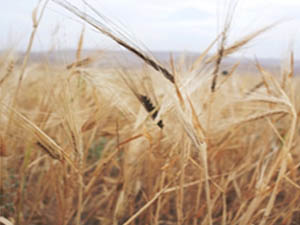 Evolutionally population of Barley in Khuzestan, Batvand, Golshan Chahian, CENESTA | 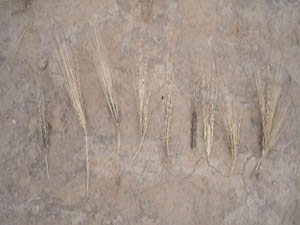 Genetic diversity of barley, Maedeh Salimi, CENESTA |
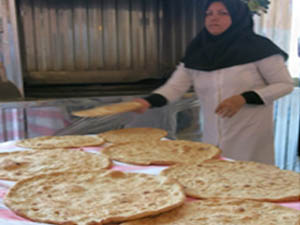 Healthy bread production, Semnan, Eyvanekey, Maedeh Salimi, CENESTA |
|||||||||

